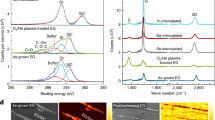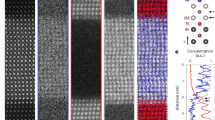Abstract
The ability of the semiconductor industry to continue scaling microelectronic devices to ever smaller dimensions (a trend known as Moore's Law1) is limited by quantum mechanical effects: as the thickness of conventional silicon dioxide (SiO2) gate insulators is reduced to just a few atomic layers, electrons can tunnel directly through the films. Continued device scaling will therefore probably require the replacement of the insulator with high-dielectric-constant (high-k) oxides2, to increase its thickness, thus preventing tunnelling currents while retaining the electronic properties of an ultrathin SiO2 film. Ultimately, such insulators will require an atomically defined interface with silicon without an interfacial SiO2 layer for optimal performance. Following the first reports of epitaxial growth of AO and ABO3 compounds on silicon3,4,5,6,7, the formation of an atomically abrupt crystalline interface between strontium titanate and silicon was demonstrated8,9,10. However, the atomic structure proposed for this interface is questionable because it requires silicon atoms that have coordinations rarely found elsewhere in nature. Here we describe first-principles calculations of the formation of the interface between silicon and strontium titanate and its atomic structure. Our study shows that atomic control of the interfacial structure by altering the chemical environment can dramatically improve the electronic properties of the interface to meet technological requirements. The interface structure and its chemistry may provide guidance for the selection process of other high-k gate oxides and for controlling their growth.
This is a preview of subscription content, access via your institution
Access options
Subscribe to this journal
Receive 51 print issues and online access
$199.00 per year
only $3.90 per issue
Buy this article
- Purchase on Springer Link
- Instant access to full article PDF
Prices may be subject to local taxes which are calculated during checkout


Similar content being viewed by others
References
Moore, G. E. Cramming more components onto integrated circuits. Electronics 38, 114–117 (1965)
Semiconductor Industry Association. International Technology Roadmap for Semiconductors at 〈http://public.itrs.net/〉 (International SEMATECH, Austin, TX, 2001).
Ishiwara, H. & Azuma, K. Oriented growth of SrTiO3 films on Si(100) substrates using in-situ cleaning by excited hydrogen. Mater. Res. Soc. 116, 369–374 (1988)
Kado, Y. & Arita, Y. Heteroepitaxial growth of SrO films on Si substrates. J. Appl. Phys. 61, 2398–2400 (1987)
Mori, H. & Ishiwara, H. Epitaxial growth of SrTiO3 films on Si(001) substrates using a focused electron beam evaporation method. J. Appl. Phys. 30, 1415–1417 (1991)
Kim, T. W. et al. Structural properties and interfacial layer formation mechanisms of PbTiO3 thin films grown on p-Si substrates. Appl. Phys. Lett. 64, 2676–2678 (1994)
Alexe, M. Measurement of interface trap states in metal ferroelectric silicon heterostructures. Appl. Phys. Lett. 72, 2283–2285 (1998)
McKee, R. A., Walker, F. J. & Chisholm, M. F. Crystalline oxides on silicon: the first five monolayers. Phys. Rev. Lett. 81, 3014–3017 (1998)
McKee, R.A. & Walker, F.J. Process for depositing an oxide epitaxially onto a silicon substrate and structures prepared with the process. US patent 5,225,031 (United States Patent Office, 1993).
McKee, R. A., Walker, F. J. & Chisholm, M. F. Physical structure and inversion charge at a semiconductor interface with a crystalline oxide. Science 293, 468–471 (2001)
Ashman, C., Först, C. J., Schwarz, K. & Blöchl, P. E. First-principles calculations of strontium adsorption on Si(001). Phys. Rev. B 69 (in the press)
Fan, W. C., Wu, N. J. & Ignatiev, A. Observation of ordered structures of Sr on the Si(001) surface. Phys. Rev. B 42, 1254–1257 (1990)
Yao, X. et al. Initial stages of Ba adsorption on the Si(100)-(2 × 1) surface at room temperature. Phys. Rev. B 59, 5115–5119 (1999)
Wang, J. et al. Bonding and diffusion of Ba on a Si(001) reconstructed surface. Phys. Rev. B 60, 4968–4971 (1999)
Liang, Y., Gan, S. & Engelhard, M. First step towards the growth of single-crystal oxides on Si: formation of a two-dimensional crystalline silicate on Si(001). Appl. Phys. Lett. 79, 3591–3593 (2001)
Wang, J., Ooms, W. J. & Hallmark, J. A. Semiconductor structure having a crystalline alkaline earth metal oxide interface with silicon. US patent 6,238,459 (United States Patent Office, 2001).
Droopad, R. et al. Epitaxial oxides on silicon grown by molecular beam epitaxy. J. Cryst. Growth 227–228, 936–943 (2001)
Robertson, J. & Peacock, P. W. Atomic structure, band offsets and hydrogen in high k oxide:silicon interfaces. Mater. Res. Soc. Symp. Proc. 747, 99–111 (2002)
Zhang, X., Demkov, A. A., Li, H., Hu, X. & Wei, Y. Atomic and electronic structure of the Si/SrTiO3 interface. Phys. Rev. B 68, 125323 (2003)
Chambers, S. A. et al. Band offset and structure of SrTiO3/Si(001) heterojunctions. J. Vac. Sci. Technol. A 19, 934–939 (2001)
Robertson, J. Band offsets of wide-band-gap oxides and implications for future electronic devices. J. Vac. Sci. Technol. B 18, 1785–1791 (2000)
Hohenberg, P. & Kohn, W. Inhomogeneous electron gas. Phys. Rev. B 136, 864–871 (1964)
Kohn, W. & Sham, L. J. Self-consistent equations including exchange and correlation effects. Phys. Rev. A 140, 1133–1138 (1965)
Noland, T. A. Optical absorption of single-crystal strontium titanate. Phys. Rev. 94, 724 (1954)
Car, R. & Parrinello, M. Unified approach for molecular dynamics and density-functional theory. Phys. Rev. Lett. 55, 2471–2474 (1985)
Perdew, J. P., Burke, K. & Ernzerhof, M. Generalized gradient approximation made simple. Phys. Rev. Lett. 77, 3865–3868 (1996)
Blöchl, P. E. Projector augmented-wave method. Phys. Rev. B 50, 17953–17979 (1994)
Gillan, M. G. Calculation of the vacancy formation energy in aluminum. J. Phys. Condens. Matter 1, 689–711 (1989)
Acknowledgements
We thank S. Chambers, M. Chisholm, W. Daum, A. Dimoulas, J. Fompeyrine, J.-P. Loquet, R.A. McKee, G. Norga and S. Stemmer for discussions. This work has been funded by the European Commission in the project ‘Integration of Very High-k Dielectrics with CMOS Technology’ (INVEST) and by the AURORA project of the Austrian Science Fund. Parts of the calculations have been performed on the computers of the ‘Norddeutscher Verbund für Hoch- und Höchstleistungsrechnen’ (HLRN).
Author information
Authors and Affiliations
Corresponding author
Ethics declarations
Competing interests
The Clausthal University of Technology has applied for a patent related to the subject of the paper. The authors will participate financially in the revenue.
Rights and permissions
About this article
Cite this article
Först, C., Ashman, C., Schwarz, K. et al. The interface between silicon and a high-k oxide. Nature 427, 53–56 (2004). https://doi.org/10.1038/nature02204
Received:
Accepted:
Issue Date:
DOI: https://doi.org/10.1038/nature02204
This article is cited by
-
A review on (Sr,Ca)TiO3-based dielectric materials: crystallography, recent progress and outlook in energy-storage aspects
Journal of Materials Science (2022)
-
Novel ferroelectric phase in bulk BaO obtained by application of anisotropic strain
Applied Physics A (2020)
-
Computational screening of high-performance optoelectronic materials using OptB88vdW and TB-mBJ formalisms
Scientific Data (2018)
-
Atomic-Scale Engineering of Abrupt Interface for Direct Spin Contact of Ferromagnetic Semiconductor with Silicon
Scientific Reports (2016)
-
Structural characterisation of slightly Fe-doped SrTiO3 grown via a sol–gel hydrothermal synthesis
Journal of Sol-Gel Science and Technology (2015)
Comments
By submitting a comment you agree to abide by our Terms and Community Guidelines. If you find something abusive or that does not comply with our terms or guidelines please flag it as inappropriate.



